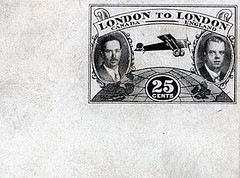
PREV ARTICLE
NEXT ARTICLE
FULL ISSUE
PREV FULL ISSUE
PRINTER'S PROOF OF RARE 1927 "LONDON TO LONDON" STAMP FOUND It's non-numismatic, but numismatists can appreciate the history and appeal of the stamp discussed in this recent article - it's akin to finding a pattern specimen of the 1804 Dollar or 1913 Liberty nickel. -Editor  This is a story about a failed first flight, a vanished shipment of airmail, a midnight robbery, and a `stamp' – lost to the world for 81 years – that fetched $10,000 last month in a Toronto auction. This is a story about a failed first flight, a vanished shipment of airmail, a midnight robbery, and a `stamp' – lost to the world for 81 years – that fetched $10,000 last month in a Toronto auction.The story begins in the summer of 1927. Charles Lindbergh has just completed the first solo flight from New York to Paris. A series of distance-stretching transatlantic adventures ensue, some successful, others not. Among those sponsoring the expansion in aviation is a small London, Ont., brewery offering $25,000 to fly from London, Ont., to London, England. The flight of The Sir John Carling (named for that local brewery) takes off in late summer, piloted by a Canadian veteran of World War I, Capt. Terrance Tully, and his navigator, James Medcalf. Laden with a light shipment of commemorative airmail and enough fuel to cross the North Atlantic, the fixed-wing six-seat aircraft takes off into bad weather on a perilous journey into history. Waiting for The Sir John Carling in England: A tickertape parade and the $25,000 reward. But Tully and Medcalf never make it. They disappear into a heavy fog off the coast of Newfoundland. The pilots, the plane and the airmail are never seen again. Eighty-one years later, a relic of the event, the only known printer's proof of the commemorative stamp – the same stamps on the mail onboard the flight – is discovered in the sock drawer of a Bay St. banker. It was a gift, given to the banker by his father who had inherited it years earlier from a friend who had gotten it directly from the printer who had cast it on paper in London, Ont., or so the story goes. It is a proof, a test stamp made by the printer before printing some 100 of the semi-official 25 cent stamps for the flight. Those stamps – made from blue and yellow die cast on white paper – show the framed portraits of Tully and Medcalf on either side of the globe along with an image of The Sir John Carling flying the Atlantic. They are worth a lot of money. "Only nine of the stamps are known to have survived," Talman says. Most of them went down with the plane, the others survived by fluke or by mischief. Four of the stamps are thought to have been given to Tully's wife before the plane took off. Folklore tells of a break-in the night of the plane crash, in which the stamps were stolen while the soon-to-be widow was out for supper. No one knows what happened to those stamps, he says. But of the nine that have surfaced in the decades since the crash, some are in private hands, others are in the British Library's stamp collection while a mint copy of one of the semi-official labels is on display in the Smithsonian. To read the complete article, see: 'Stamp' found in sock drawer reopens 1927 intrigue (http://www.thestar.com/News/article/568999) Wayne Homren, Editor The Numismatic Bibliomania Society is a non-profit organization promoting numismatic literature. See our web site at coinbooks.org. To submit items for publication in The E-Sylum, write to the Editor at this address: whomren@gmail.com To subscribe go to: https://my.binhost.com/lists/listinfo/esylum All Rights Reserved. NBS Home Page Contact the NBS webmaster 
|